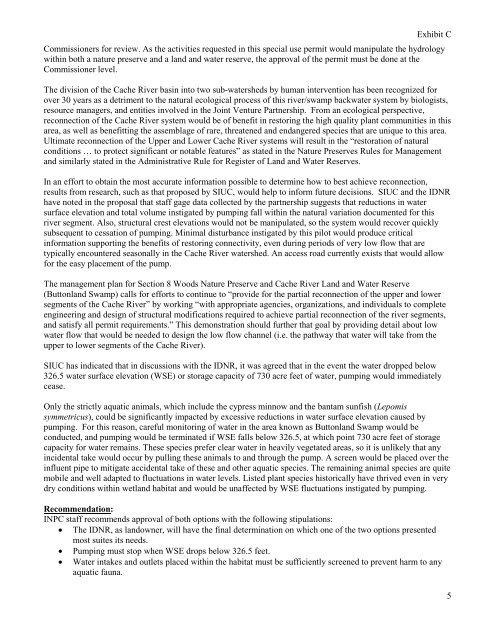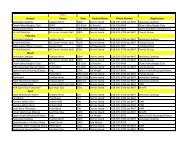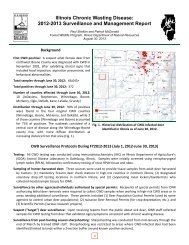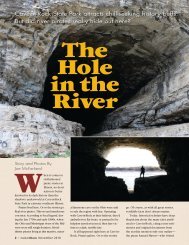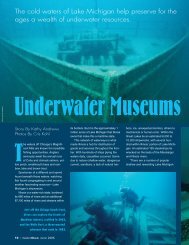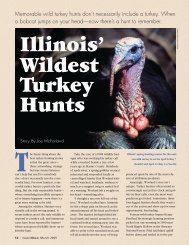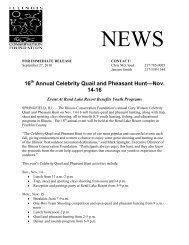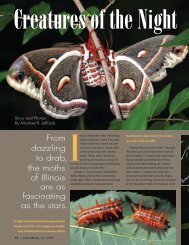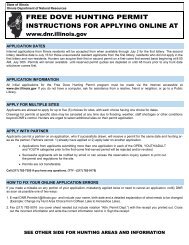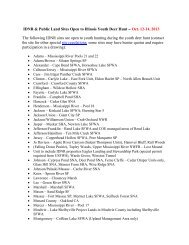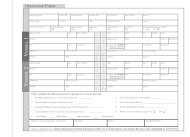ILLINOIS NATURE PRESERVES COMMISSION - Illinois DNR
ILLINOIS NATURE PRESERVES COMMISSION - Illinois DNR
ILLINOIS NATURE PRESERVES COMMISSION - Illinois DNR
- No tags were found...
You also want an ePaper? Increase the reach of your titles
YUMPU automatically turns print PDFs into web optimized ePapers that Google loves.
Exhibit CCommissioners for review. As the activities requested in this special use permit would manipulate the hydrologywithin both a nature preserve and a land and water reserve, the approval of the permit must be done at theCommissioner level.The division of the Cache River basin into two sub-watersheds by human intervention has been recognized forover 30 years as a detriment to the natural ecological process of this river/swamp backwater system by biologists,resource managers, and entities involved in the Joint Venture Partnership. From an ecological perspective,reconnection of the Cache River system would be of benefit in restoring the high quality plant communities in thisarea, as well as benefitting the assemblage of rare, threatened and endangered species that are unique to this area.Ultimate reconnection of the Upper and Lower Cache River systems will result in the “restoration of naturalconditions … to protect significant or notable features” as stated in the Nature Preserves Rules for Managementand similarly stated in the Administrative Rule for Register of Land and Water Reserves.In an effort to obtain the most accurate information possible to determine how to best achieve reconnection,results from research, such as that proposed by SIUC, would help to inform future decisions. SIUC and the I<strong>DNR</strong>have noted in the proposal that staff gage data collected by the partnership suggests that reductions in watersurface elevation and total volume instigated by pumping fall within the natural variation documented for thisriver segment. Also, structural crest elevations would not be manipulated, so the system would recover quicklysubsequent to cessation of pumping. Minimal disturbance instigated by this pilot would produce criticalinformation supporting the benefits of restoring connectivity, even during periods of very low flow that aretypically encountered seasonally in the Cache River watershed. An access road currently exists that would allowfor the easy placement of the pump.The management plan for Section 8 Woods Nature Preserve and Cache River Land and Water Reserve(Buttonland Swamp) calls for efforts to continue to “provide for the partial reconnection of the upper and lowersegments of the Cache River” by working “with appropriate agencies, organizations, and individuals to completeengineering and design of structural modifications required to achieve partial reconnection of the river segments,and satisfy all permit requirements.” This demonstration should further that goal by providing detail about lowwater flow that would be needed to design the low flow channel (i.e. the pathway that water will take from theupper to lower segments of the Cache River).SIUC has indicated that in discussions with the I<strong>DNR</strong>, it was agreed that in the event the water dropped below326.5 water surface elevation (WSE) or storage capacity of 730 acre feet of water, pumping would immediatelycease.Only the strictly aquatic animals, which include the cypress minnow and the bantam sunfish (Lepomissymmetricus), could be significantly impacted by excessive reductions in water surface elevation caused bypumping. For this reason, careful monitoring of water in the area known as Buttonland Swamp would beconducted, and pumping would be terminated if WSE falls below 326.5, at which point 730 acre feet of storagecapacity for water remains. These species prefer clear water in heavily vegetated areas, so it is unlikely that anyincidental take would occur by pulling these animals to and through the pump. A screen would be placed over theinfluent pipe to mitigate accidental take of these and other aquatic species. The remaining animal species are quitemobile and well adapted to fluctuations in water levels. Listed plant species historically have thrived even in verydry conditions within wetland habitat and would be unaffected by WSE fluctuations instigated by pumping.Recommendation:INPC staff recommends approval of both options with the following stipulations:• The I<strong>DNR</strong>, as landowner, will have the final determination on which one of the two options presentedmost suites its needs.• Pumping must stop when WSE drops below 326.5 feet.• Water intakes and outlets placed within the habitat must be sufficiently screened to prevent harm to anyaquatic fauna.5


